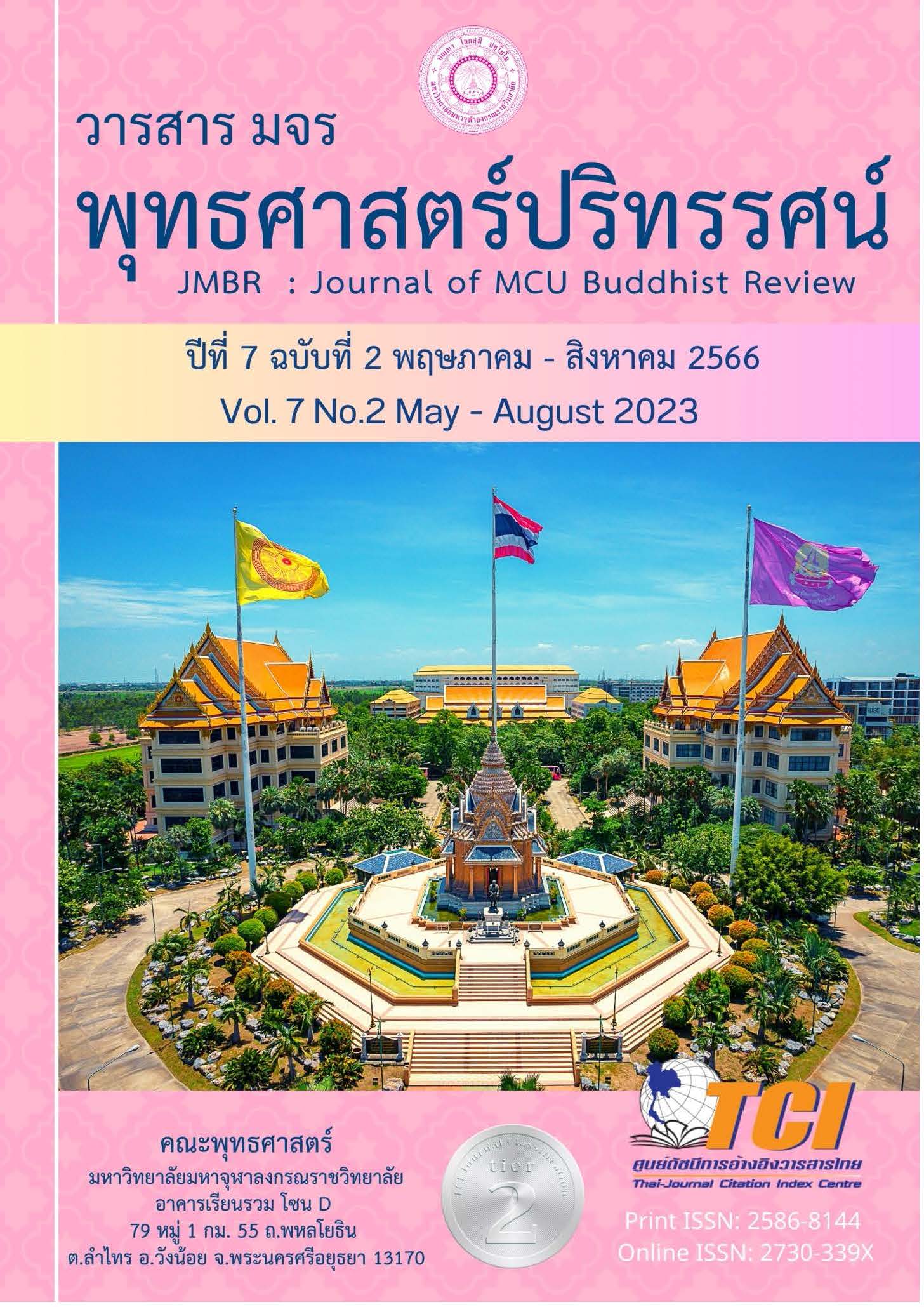ศึกษาวิเคราะห์การบรรลุธรรมในธัมมจักกัปปวัตตนสูตร
Main Article Content
บทคัดย่อ
บทความวิจัยนี้มีวัตถุประสงค์ 1) เพื่อศึกษาโครงสร้างและสาระสำคัญของธัมมจักกัปปวัตตนสูตร
2) เพื่อศึกษาการบรรลุธรรมในคัมภีร์พระไตรปิฎก 3) เพื่อวิเคราะห์การบรรลุธรรมในธัมมจักกัปปวัตตนสูตร เป็นการวิจัยเชิงคุณภาพ โดยรวบรวมข้อมูลทั้งจากเอกสาร และงานวิจัยที่เกี่ยวข้องกับการบรรลุธรรมในธัมม จักกัปปวัตตนสูตร แล้วนำมาวิเคราะห์ถึงความเหมือนและแตกต่างกัน การร่วมสนทนากลุ่มเฉพาะ และการอบรมจากนักวิชาการพระพุทธศาสนา
ผลการวิจัยพบว่า 1) ธัมมจักกัปปวัตตนสูตรปรากฏเนื้อหาอยู่ในคัมภีร์พระไตรปิฎกเล่มที่ 19 หรือ พระสุตตันตปิฎกเล่มที่ 11 สังยุตตนิกาย มหาวารวรรค,สัจจสังยุต, พระวินัยปิฎกเล่มที่ 4 มหาวรรค,มหาขันธกะ โครงสร้างของธัมมจักกัปปวัตตนสูตร หมวดว่าด้วยการประกาศพระธรรมจักร (1) กามสุขัลลิกานุโยค (2) อัตตกิลมถานุโยค (3) อริยสัจ 4 (4) อริยมรรคมีองค์ 8 (5) ญาณทัสสนะ เนื้อหาว่าด้วยเรื่องการประกาศพระธรรมจักร ทรงแสดงที่สุด 2 ประการบรรพชิตไม่พึงเสพ (1) กามสุขัลลิกานุโยค (2) อัตตกิลมถานุโยค อริยมรรคมีองค์ 8 ประการหรือมัชฌิมาปฏิปทาทางที่ควรดำเนิน อริยสัจ 4 ความจริงอันประเสริฐ 4 ประการ คือทุกข์,สมุทัย,นิโรธ,มรรค ควรทำให้ประจักษ์แจ้ง 2) การบรรลุธรรมในพระไตรปิฎก การบรรลุธรรมตามทัศนะของพุทธศาสนาเถรวาท หมายเอาการปฏิบัติธรรมจนเป็นพระอริยบุคคลผู้ประเสริฐผู้ไกลจากข้าศึกคือกิเลส การปฏิบัติตามมรรคมีองค์ 8 และอริยสัจ 4 ผู้ปฏิบัติสามารถรู้แจ้งแทงตลอดอริยสัจ 4 ละสังโยชน์ได้ไปโดยลำดับได้ตามกำลังของมรรคบรรลุมรรคผลนิพพาน สำเร็จเป็นพระอริยบุคคลในพระพุทธศาสนา 3) การบรรลุธรรมในธัมมจักกัปปวัตตนสูตรพบว่า คือการประกาศทางสายกลาง ซึ่งเป็นข้อปฏิบัติที่ไม่เอียงไปทางกามสุขัลลิกานุโยค อันเป็นการประกอบตนแสวงหาความสุขจากกามคุณทั้ง 5 และไม่เอียงไปทางอัตตกิลมถานุโยคอันเป็นการทรมานตนโดยหาประโยชน์มิได้ แล้วพึงปฏิบัติตามหนทางสายกลางนี้ประกอบด้วยมรรคมีองค์ 8 และทำให้ประจักษ์แจ้งในอริยสัจ 4 ซึ่งข้อปฏิบัติทางสายกลางนี้เป็นข้อปฏิบัติอันกระทำให้จักษุ,ญาณ,ปัญญา,วิชชา,และแสงสว่างให้เกิดขึ้น เพื่อการบรรลุธรรมเป็นไปเพื่อนิพพาน
Article Details

อนุญาตภายใต้เงื่อนไข Creative Commons Attribution-NonCommercial-NoDerivatives 4.0 International License.
- บทความที่ได้รับการตีพิมพ์เป็นลิขสิทธิ์ของวารสาร มจร พุทธศาสตร์ปริทรรศน์
- ข้อความใดๆ ที่ปรากฎในบทความที่ได้รับการตีพิมพ์ในวารสาร ถือเป็นความรับผิดชอบของผู้เขียนบทความ และข้อคิดเห็นนั้นไม่ถือว่าเป็นทัศนะและความรับผิดชอบของกองบรรณาธิการวารสาร มจร พุทธศาสตร์ปริทรรศน์
เอกสารอ้างอิง
ณัฐญา พลเสน. (2560). การจัดการความรู้ในสถาบันการศึกษาด้วยหลักไตรสิกขา. วารสารครุศาสตร์ ปริทรรศน์, 1(1), 68.
พระมหาบุญชิต ญาณสํวโร (สุดโปรง). (2537). ศึกษาคุณสมบัติของพระอรหันต์ในพระพุทธศาสนาเถรวาท. วิทยานิพนธ์อักษรศาสตรมหาบัณฑิต บัณฑิตวิทยาลัย: มหาวิทยาลัยมหิดล.
พระมหาพงศ์ศักดิ์ ฐานิโย. (2560). การวิจัยเชิงคัมภีร์: กรณีศึกษาธัมมจักกัปปวัตนสูตร. ธรรมธาราวารสารวิชาการทางพระพุทธศาสนา. 2(1), 2.
พระมหามีนา ถาวโร (ไชยอุด). (2558). ศึกษาการบรรลุธรรมของพระวังคีสเถระ. วิทยานิพนธ์พุทธศาสตรมหาบัณฑิต บัณฑิตวิทยาลัย: มหาวิทยาลัยมหาจุฬาลงกรณราชวิทยาลัย.
พระมหาสามารถ อธิจิตฺโต (มนัส). (2554). ศึกษาการบรรลุธรรมด้วยการเจริญอานาปานสติในคัมภีร์พุทธศาสนาเถรวาท. วิทยานิพนธ์พุทธศาสตรมหาบัณฑิต บัณฑิตวิทยาลัย: มหาวิทยาลัยมหาจุฬาลงกรณราชวิทยาลัย.
พระมหาอำนวย อานนฺโท (จันทร์เปล่ง). (2542). การศึกษาเรื่องการบรรลุธรรมในพระพุทธศาสนาเถรวาท. วิทยานิพนธ์พุทธศาสตรมหาบัณฑิต บัณฑิตวิทยาลัย: มหาวิทยาลัยมหาจุฬาลงกรณราชวิทยาลัย.
มหาจุฬาลงกรณราชวิทยาลัย. (2539). พระไตรปิฎกภาษาไทย ฉบับมหาจุฬาลงกรณราชวิทยาลัย. กรุงเทพฯ: มหาจุฬาลงกรณราชวิทยาลัย.
สุมานพ ศิวารัตนะ. (2560). การพัฒนาคุณภาพชีวิตด้วยไตรสิกขา. วารสารสถาบันวิชาการป้องกันประเทศ. 8(1), 40.
อำนาจ บัวศิริ. (2561). กระบวนการสร้างภาวะผู้นำด้วยหลักไตรสิกขา. วารสารครุศาสตร์ปริทรรศน์. 5(3), 31.


